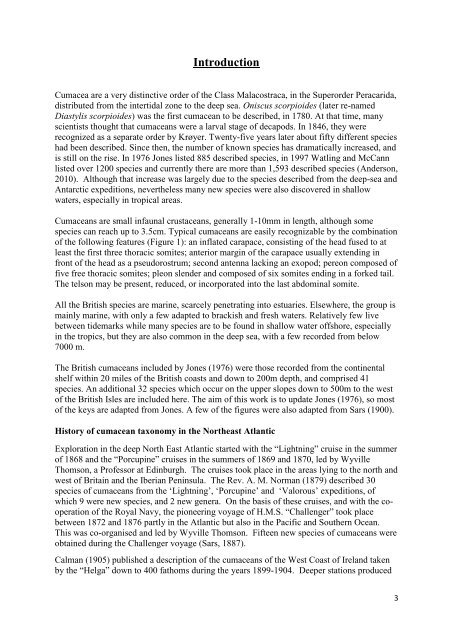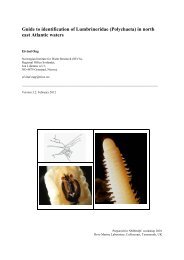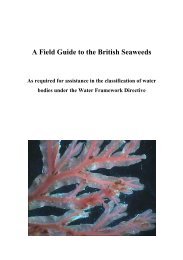You also want an ePaper? Increase the reach of your titles
YUMPU automatically turns print PDFs into web optimized ePapers that Google loves.
Introduction<br />
Cumacea are a very distinctive order of the Class Malacostraca, in the Superorder Peracarida,<br />
distributed from the intertidal zone to the deep sea. Oniscus scorpioides (later re-named<br />
Diastylis scorpioides) was the first cumacean to be described, in 1780. At that time, many<br />
scientists thought that cumaceans were a larval stage of decapods. In 1846, they were<br />
recognized as a separate order by Krøyer. Twenty-five years later about fifty different species<br />
had been described. Since then, the number of known species has dramatically increased, and<br />
is still on the rise. In 1976 Jones listed 885 described species, in 1997 Watling and McCann<br />
listed over 1200 species and currently there are more than 1,593 described species (Anderson,<br />
2010). Although that increase was largely due to the species described from the deep-sea and<br />
Antarctic expeditions, nevertheless many new species were also discovered in shallow<br />
waters, especially in tropical areas.<br />
Cumaceans are small infaunal crustaceans, generally 1-10mm in length, although some<br />
species can reach up to 3.5cm. Typical cumaceans are easily recognizable by the combination<br />
of the following features (Figure 1): an inflated carapace, consisting of the head fused to at<br />
least the first three thoracic somites; anterior margin of the carapace usually extending in<br />
front of the head as a pseudorostrum; second antenna lacking an exopod; pereon composed of<br />
five free thoracic somites; pleon slender and composed of six somites ending in a forked tail.<br />
The telson may be present, reduced, or incorporated into the last abdominal somite.<br />
All the British species are marine, scarcely penetrating into estuaries. Elsewhere, the group is<br />
mainly marine, with only a few adapted to brackish and fresh waters. Relatively few live<br />
between tidemarks while many species are to be found in shallow water offshore, especially<br />
in the tropics, but they are also common in the deep sea, with a few recorded from below<br />
7000 m.<br />
The British cumaceans included by Jones (1976) were those recorded from the continental<br />
shelf within 20 miles of the British coasts and down to 200m depth, and comprised 41<br />
species. An additional 32 species which occur on the upper slopes down to 500m to the west<br />
of the British Isles are included here. The aim of this work is to update Jones (1976), so most<br />
of the keys are adapted from Jones. A few of the figures were also adapted from Sars (1900).<br />
History of cumacean taxonomy in the Northeast Atlantic<br />
Exploration in the deep North East Atlantic started with the “Lightning” cruise in the summer<br />
of 1868 and the “Porcupine” cruises in the summers of 1869 and 1870, led by Wyville<br />
Thomson, a Professor at Edinburgh. The cruises took place in the areas lying to the north and<br />
west of Britain and the Iberian Peninsula. The Rev. A. M. Norman (1879) described 30<br />
species of cumaceans from the „Lightning‟, „Porcupine‟ and „Valorous‟ expeditions, of<br />
which 9 were new species, and 2 new genera. On the basis of these cruises, and with the cooperation<br />
of the Royal Navy, the pioneering voyage of H.M.S. “Challenger” took place<br />
between 1872 and 1876 partly in the Atlantic but also in the Pacific and Southern Ocean.<br />
This was co-organised and led by Wyville Thomson. Fifteen new species of cumaceans were<br />
obtained during the Challenger voyage (Sars, 1887).<br />
Calman (1905) published a description of the cumaceans of the West Coast of Ireland taken<br />
by the “Helga” down to 400 fathoms during the years 1899-1904. Deeper stations produced<br />
3




